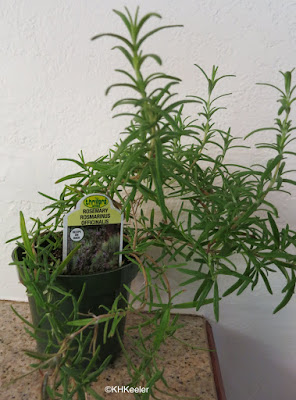Rosemary is a sun-loving plant of the rocky areas along the Mediterranean Sea, from the south of Spain into the Middle East. Her leaves are long and fragrant, her flowers a beautiful purple. Long ago humans found her scent calming and the oils in her leaves a fine flavoring. She had two close relatives, sisters you might say, but they grew only in local areas near her, while rosemary herself was carried around the world by humans. (See previous blog about rosemary link).
But one day, in 2015, botanists sent rosemary's DNA off to the botanical equivalent AncestryDNA and when the results came back, they were shocking.
Rosemary has dozens and dozens of sisters and brothers, most of them going by the name Salvia (sage). Salvia is a world-wide genus of over 1,000 species.
 |
| garden sage, Salvia officinalis |
This shocked lots of people--just like finding unknown sisters and cousins shocks people who get DNA tests.
 |
| rosemary leaves |
As is the scientific procedure, Drew and coauthors wrote out their data and their logic and published it. If readers are convinced, then they will follow the researchers' recommendations, in this case, calling rosemary Salvia rosmarinus. If they are not convinced, they can go on using the old name or, better, publish their objections, with data to support their view, and everyone can consider the pros and cons of the evidence offered.
Geeky Botanical Stuff:
For the curious, here is what this reclassification did to the three species previously in the genus Rosmarinus: Common rosemary retains the name rosmarinus, but now as the species epithet: Salvia rosmarinus. The old name Rosmarinus officinalis is lost. It becomes a synonym, "synonym"in botany being a name that has been superceded. Rosmarinus ceases to be a genus. For rosemary, "officinalis" (which means "of the shop," that is, the one the herbalist prescribed) is also lost in the reclassification. There are at least two reasons for that. First, because without using rosmarinus as the species epithet, the scientific name would give you no clue it is the plant with the common name rosemary--imagine it as Salvia laxiflorus, a name used for rosemary in 1863. Second there already is a Salvia officinalis, culinary sage. Drew and coauthors followed naming botanical naming rules as well: the name Salvia rosmarinus for rosemary was proposed in 1852 (!) so it has seniority over Salvia laxiflorus as a name for rosemary.
The other two species that were in the genus Rosmarinus, Rosmarinus tomentosus and R. eriocalyx will be harder to relate to rosemary in the future, since they became Salvia granatensis (because it grows primarily around Granada, Spain) and S. jordanii (commemorating the French botanist Claude Jordan (1814-1897) who described it in 1866). Conserving the species epithet is preferred but there already were both a Salvia tomentosa and Salvia eriocalyx. Classification within Salvia willl continue to show they are rosemaries: they cluster with rosemary within Salvia.
End Geeky Stuff
In the short term, this change has aroused dramatic reactions from the public -- As seen in these memes from the Facebook page Phytomemetics
(John Stewart on Facebook: Phytomemetics)
(Jesse Vaillancourt on Facebook: Phytomemetics)
(John Stewart on Facebook: Phytomemetics)
I read the paper and I am persuaded. I will hereafter give the scientific name of rosemary as Salvia rosmarinus.
 |
| meadow sage, Salvia praetensis |
 |
| clary sage, Salvia sclarea |
If you had learned Rosmarinus officinalis and now need to learn Salvia rosmarinus for the same plant, that makes you part of progress in our society, same as learning to navigate with Siri or go through customs with your e-passport. Challenging on the first experience, but making things overall better.
 |
| Rosemary, Salvia rosmarinus Awestruck: "Wow, I always wanted more brothers and sisters." |
Comments and corrections welcome.
References
Drew, B.T., J. Gonzalez-Gallegos, C.-L. Xiang, R. Kriebel, C. P.. Drummond, J. B. Walker and K. J. Sytsma. 2017. Salvia united: the greatest good for the greatest number. Taxon 66 (1): 133-145. (link-broken)
Note: 9/23/19 This links to the journal: Taxon. You can see the abstract but not the whole text. I think you can download the full paper from Researchgate.net if you join it (apparently free).
***Author K. J. Sytsma of U. Wisconsin has the full paper on his website (link) at least for now. Authors want readers and science is based on information exchange, so checking out authors' webpages will often get you an online copy. It is the publishers who don't want to give away the articles, which of course makes sense to their bottom line.
Commenting on this blog has also changed and I have not yet figured out how to comment; it used to be simple. Thank you Nina for pointing out the broken link. Everyone, please let me know if there are further glitches.
My thanks to meme-writers John Stewart and Jesse Vaillancourt.
Kathy Keeler, A Wandering Botanist
More at awanderingbotanist.com
Join me on Facebook: https://www.facebook.com/AWanderingBotanist






The reference link doesn't work :(
ReplyDeleteThanks for this post. Greetings from Sweden.
ReplyDeleteBlimey I must have missed this. And Perovskia atriplicifolia is now Salvia yangii.... why did they change the second, species, name?
ReplyDeleteGrateful for sharing tthis
ReplyDeletesages have round stems, rosemary has square stem, sages have leaves, rosemary has needles, both are lamiaceae but. . . Rosemary is NOT as sage. Richo Cech, Strictly Medicinal Seeds
ReplyDelete